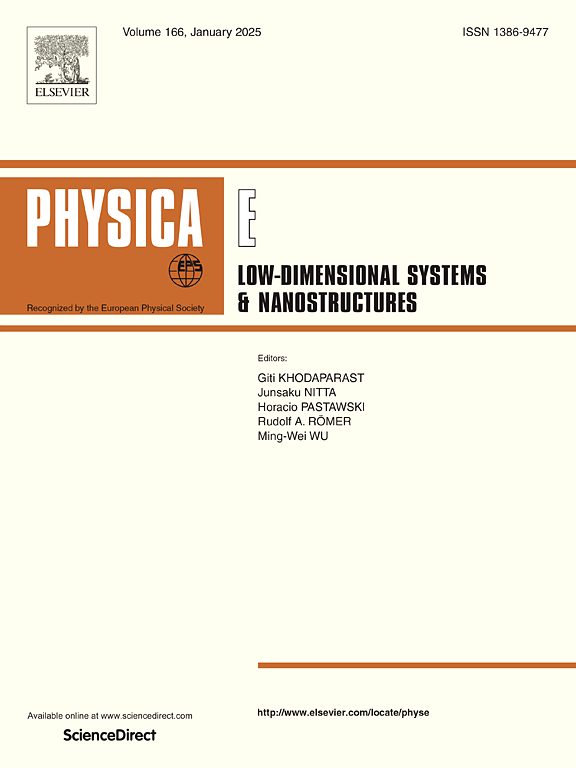Two-dimensional GaN of wurtzite、hexagonal and haeckelite (4|8) structure with multiple layers: A first principle DFT study on structural and optoelectronic properties
IF 2.9
3区 物理与天体物理
Q3 NANOSCIENCE & NANOTECHNOLOGY
Physica E-low-dimensional Systems & Nanostructures
Pub Date : 2025-01-13
DOI:10.1016/j.physe.2025.116193
引用次数: 0
Abstract
This study aims to investigate the optoelectronic properties of three different structures of two-dimensional GaN, namely wurtzite, hexagonal, and haeckelite, through first-principles calculations. The goal is to provide a theoretical foundation for the design and development of high-performance optoelectronic devices. As a new type of semiconductor material, two-dimensional GaN has attracted much attention due to its excellent optoelectronic properties. In our study, we found that as the layer thickness increases, the optimal structure of two-dimensional GaN transitions from the hexagonal phase to the haeckelite phase, and finally stabilizes in the wurtzite structure. During this process, the work function continuously increases and tends to stabilize, with the wurtzite structure's work function eventually stabilizing at 5.50 eV, while the work functions of the hexagonal and haeckelite (4|8) structures stabilize around 7.35 eV. The wurtzite structure exhibits a significantly enhanced internal electric field between layers, whereas the hexagonal and haeckelite structures do not show interlayer polarization due to the coincidence of positive and negative charge centers. Compared to bulk materials, two-dimensional GaN shows a larger bandgap, which gradually decreases with increasing layer thickness and tends to stabilize at around 10 layers. The hexagonal structure has the largest bandgap, while the wurtzite and haeckelite structures have relatively smaller bandgaps. Specifically, the bandgap of the wurtzite structure decreases from 5 eV for a single layer to approximately 1.50 eV at around 10 layers. The hexagonal structure exhibits the largest bandgap of 2.61 eV at 5 layers, stabilizing at around 2.60 eV at 10 layers. The haeckelite structure's bandgap decreases from 2.71 eV at 5 layers to 1.61 eV at 15 layers. The valence band maximum is primarily contributed by the p-states of nitrogen and gallium, while the conduction band minimum originates from the hybridization of the s-orbitals of nitrogen and gallium. Additionally, the effective mass continuously decreases with increasing layer thickness, with the haeckelite structure showing the highest effective mass of 0.97m0 at a single layer, reducing to 0.27m0 at 15 layers. Our research also examined the optical properties of these three structures, providing a comprehensive understanding of the optoelectronic performance of two-dimensional GaN. These findings not only reveal the relationship between the structure and properties of two-dimensional GaN but also offer important references for future applications in the field of solid-state optoelectronics.

求助全文
约1分钟内获得全文
求助全文
来源期刊
CiteScore
7.30
自引率
6.10%
发文量
356
审稿时长
65 days
期刊介绍:
Physica E: Low-dimensional systems and nanostructures contains papers and invited review articles on the fundamental and applied aspects of physics in low-dimensional electron systems, in semiconductor heterostructures, oxide interfaces, quantum wells and superlattices, quantum wires and dots, novel quantum states of matter such as topological insulators, and Weyl semimetals.
Both theoretical and experimental contributions are invited. Topics suitable for publication in this journal include spin related phenomena, optical and transport properties, many-body effects, integer and fractional quantum Hall effects, quantum spin Hall effect, single electron effects and devices, Majorana fermions, and other novel phenomena.
Keywords:
• topological insulators/superconductors, majorana fermions, Wyel semimetals;
• quantum and neuromorphic computing/quantum information physics and devices based on low dimensional systems;
• layered superconductivity, low dimensional systems with superconducting proximity effect;
• 2D materials such as transition metal dichalcogenides;
• oxide heterostructures including ZnO, SrTiO3 etc;
• carbon nanostructures (graphene, carbon nanotubes, diamond NV center, etc.)
• quantum wells and superlattices;
• quantum Hall effect, quantum spin Hall effect, quantum anomalous Hall effect;
• optical- and phonons-related phenomena;
• magnetic-semiconductor structures;
• charge/spin-, magnon-, skyrmion-, Cooper pair- and majorana fermion- transport and tunneling;
• ultra-fast nonlinear optical phenomena;
• novel devices and applications (such as high performance sensor, solar cell, etc);
• novel growth and fabrication techniques for nanostructures

 求助内容:
求助内容: 应助结果提醒方式:
应助结果提醒方式:


